You searched for: 5G基站项目系统搭建【TG���������@EK7676】平台包网搭建5G基站项目系统搭建【TG���������@EK7676】平台包网搭建mOHC8Gtglh
<< Previous | Displaying results 76-100 of 250 for "5G基站项目系统搭建【TG���������@EK7676】平台包网搭建5G基站项目系统搭建【TG���������@EK7676】平台包网搭建mOHC8Gtglh" | Next >>
-
Theresienstadt: Final Weeks, Liberation, and Postwar Trials
ArticleThe Theresienstadt camp-ghetto existed from 1941 to 1945. Learn about its final weeks, liberation, and the postwar trials of SS commandants and other staff.
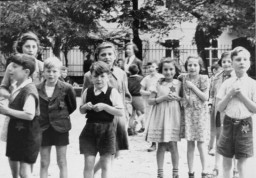
-
Wall surrounding the cemetery at Hadamar
PhotoView of the wall surrounding the cemetery of the Hadamar euthanasia killing center. Jagged pieces of glass were placed on the wall to discourage observers. This photograph was taken by an American military photographer soon after the liberation of Hadamar. Germany, April 5, 1945.
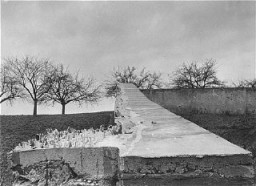
-
US Army soldier views the cemetery at Hadamar
PhotoA US Army soldier views the cemetery at Hadamar, where victims of the Nazi euthanasia program were buried in mass graves. This photograph was taken by an American military photographer soon after the liberation. Germany, April 5, 1945.
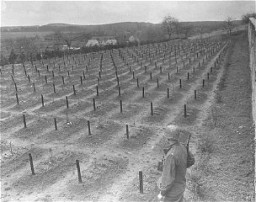
-
Sergeant Alexander Drabik, first American soldier to cross the Rhine at Remagen
PhotoSergeant Alexander Drabik, the first American soldier to cross the bridge at Remagen, receiving the Distinguished Service Cross for his heroism. April 5, 1945. US Army Signal Corps photograph taken by J Malan Heslop.
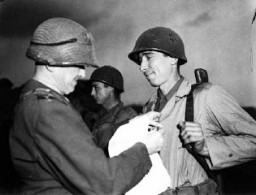
-
German children read an anti-Jewish propaganda book titled Der Giftpilz
PhotoGerman children read an anti-Jewish propaganda book for children titled Der Giftpilz (The Poisonous Mushroom). The girl on the left holds a companion volume, the translated title of which is "Trust No Fox." Germany, ca. 1938. (Source record ID: E39 Nr .2381/5)
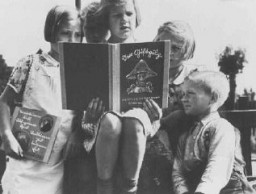
-
Liberated Soviet and Polish prisoners at Mauthausen
PhotoSoviet and Polish prisoners with disabilities stand in front of a tank of the 11th Armored Division, US Third Army. This photograph was taken at the Mauthausen concentration camp immediately after liberation. Austria, May 5–7, 1945.
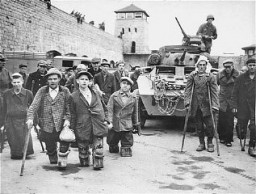
-
Secretary of State Cordell Hull signs the Neutrality Law
PhotoFour days after the outbreak of World War II, Secretary of State Cordell Hull signs the Neutrality Proclamation (first signed by President Franklin D. Roosevelt) at the State Department. Washington, DC, United States, September 5, 1939.
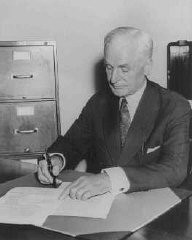
-
General Dwight D. Eisenhower with paratroopers of the 101st Airborne Division
PhotoGeneral Dwight D. Eisenhower visits with paratroopers of the 101st Airborne Division just hours before their jump into German-occupied France (D-Day). June 5, 1944.
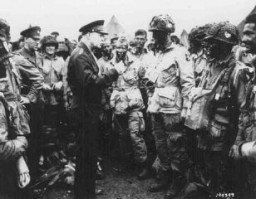
-
SS chief Heinrich Himmler visits the Lodz ghetto
PhotoAn official visit of Heinrich Himmler to the Lodz ghetto. Mordechai Chaim Rumkowski, head of the Jewish council, greets the Nazi officials. Lodz, Poland, June 5, 1941.
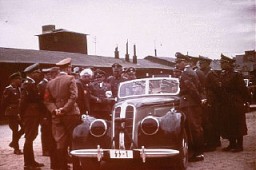
-
Aron in Budapest, 1945
PhotoAron in Budapest, 1945, while en route from Poland to Italy with Brihah, moving to Palestine. In Aron's words: "We got connected with the Brihah in Poland, got directions to go to Bratislava and on to Budapest. On our trip, we didn't know where we going from city to city, only our final destination." July 5, 1945, Budapest, Hungary.
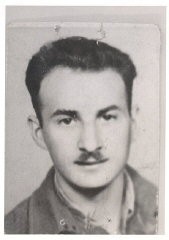
-
Tunisia Campaign
ArticleLearn more about the 1943 Tunisia campaign, a four-month long struggle between Allied and Axis powers in North Africa during World War II.
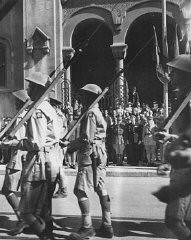
-
Luxembourg
ArticleBefore WWII, over 3,500 Jews lived in Luxembourg. Under the German occupation, this community was almost completely destroyed. Learn more.
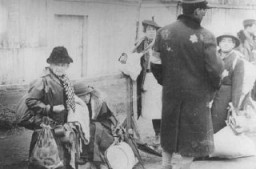
-
Latvia
ArticleBetween 1940 and 1944, Latvia was occupied by the Soviets and then by the Germans. These occupations had grave consequences for Jews in Latvia. Learn more.
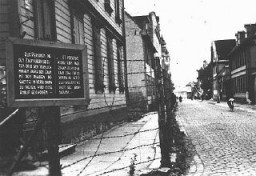
-
Fire Oaths
Article“Fire Oaths” were statements that declared why the works of certain authors were thrown into the flames during the 1933 burning of books under the Nazi regime.

-
Bad Gastein Displaced Persons Camps
ArticleAfter WWII, many Holocaust survivors, unable to return to their homes, lived in displaced persons camps in Germany, Austria, and Italy. Read about Bad Gastein DP camp.
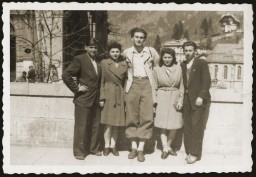
-
Nursing staff at the Hadamar "euthanasia" facility
PhotoSome of the nursing staff of the "euthanasia" clinic at Hadamar stand outside of the institution after the arrival of US forces, April 5, 1945. Irmgard Huber, the head nurse of the clinic, is probably the person standing fifth from the right. © IWM EA 62183
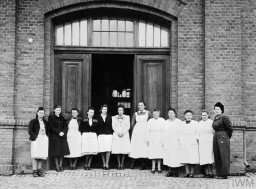
-
Jews liberated from the Gęsiówka camp during the Warsaw uprising
PhotoA member of the Zoska battalion of the Armia Krajowa escorts two of 348 Jews liberated from the Gęsiówka concentration camp during the Warsaw Polish uprising. August 5, 1944.
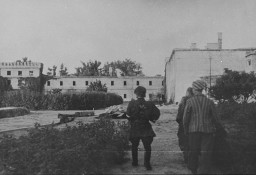
-
The 65th Infantry Division during World War II
ArticleThe 65th Infantry Division participated in major WWII campaigns and is recognized for liberating a subcamp of Flossenbürg in 1945.
-
Second telegram from the Chief Rabbi of Vilna asking for aid
DocumentA second RCA Radiogram telegram from Rabbi Grodzenski, Chief Rabbi of Vilna, to the Central Relief Committee in New York. He requests aid for refugees who have gathered in Vilna. The telegram says that more than 1,600 yeshiva students and their families from over 10 cities throughout Poland have fled to Vilna, where they remain in terrible living conditions. November 5, 1939. [From the USHMM special exhibition Flight and Rescue.]
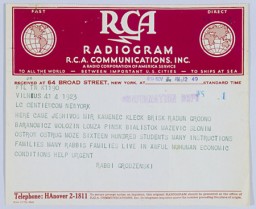
-
Wool Bedcover
ArtifactFollowing the Soviet occupation of Lithuania, the Lifszyc family began to search for ways to leave the country. David Lifszyc obtained a Curacao visa from the Dutch consulate. He also obtained an American visa because he was included on a list of distinguished rabbis submitted to the State Department by the Agudat Israel of America. After obtaining Soviet exit visas, the Lifszycs purchased tickets for Vladivostok on February 5, 1941. They started for Moscow, where they received Japanese transit visas. This…
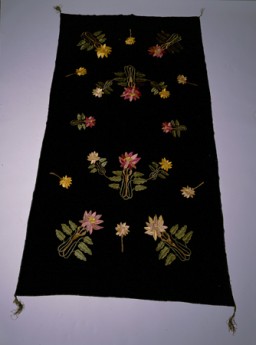
-
Beifeld album page illustrating fortifications and first fatality
Artifact(Bottom) View of fortifications built at Kalimovka to defend the advancing troops of the 4th Infantry Division of the Hungarian 2nd Army. In the lower right corner of the drawing, men prepare the grave of Jewish Labor Serviceman Nandor Klein, the first fatality of the company. The Hungarian caption reads: The death of our first hero, Nandor Klein, his grave, June 5, 1942." Klein was killed by a stray Soviet bullet on his way back to base. [Photograph #58013]
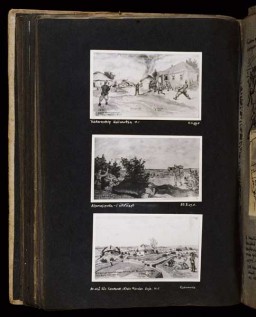
-
Adolf Hitler greets Paul von Hindenburg
PhotoRecently appointed as German chancellor, Adolf Hitler greets President Paul von Hindenburg in Potsdam, Germany, on March 21, 1933. This pose was designed to project an image of Hitler as non-threatening to the established order. This particular image is from a popular postcard. The photo also appeared widely in both the German and international press. Hitler appears in civilian dress, bowing in deference to the heavily decorated von Hindenburg. The March 5, 1933, elections had conferred legitimacy on…
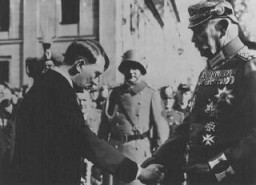
-
Auschwitz I camp, 1944
MapSelected Features 1. Camp Commandant's House 2. Main Guard House 3. Camp Administrative Office 4. Gestapo 5. Reception Building/Prisoner Registration 6. Kitchen 7. Gas Chamber and Crematorium 8. Storage Buildings and Workshops 9. Storage of Confiscated Belongings 10. Gravel Pit: Execution Site 11. Camp Orchestra Site 12. "Black Wall" Execution Site 13. Block 11: Punishment Bunker 14. Block 10: Medical Experiments 15. Gallows 16. Block Commander's Barracks 17. SS Hospital

-
Two young brothers in the Kovno ghetto
PhotoTwo young brothers, seated for a family photograph in the Kovno ghetto. One month later, they were deported to the Majdanek camp. Kovno, Lithuania, February 1944. Pictured are Avram (5 years) and Emanuel Rosenthal (2 years). Emanuel was born in the Kovno ghetto. The children, who were deported in the March 1944 "Children's Action," did not survive. Their uncle, Shraga Wainer, who had asked George Kadish to take this photograph, received a copy of it from the photographer after the war in the Landsberg…
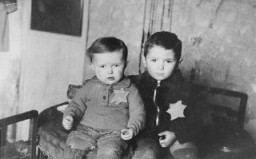
-
Hainichen
ArticleIn 1933, the Nazis established the Hainichen labor camp in Sachsen, Germany. Learn more about the camp, its closing, and the prisoners.
